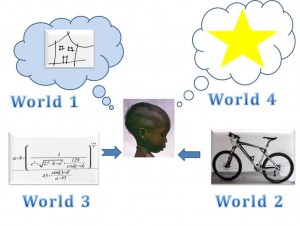Did you know that moving abroad can cause your children to have deep-seated identity issues that may not be apparent until years later?
By then, this may have
- caused schooling problems,
- damaged their career,
- adversely affected their relationships or
- even worse, triggered a depression.
Your children will suffer from external problems, the internal root of which they will not understand.
In this article, we’re going to take a closer look at how a person’s sense of identity is formed and why it’s so critical for Third Culture Kids.
This is important because when you understand this, you’ll be able to talk to your children about it and take proactive measures to raise their awareness and bridge the gaps, the sooner the better.
A couple of weeks ago, I came across the 4 world model presented by John Joseph, founder of Focus, a specialist in children learning behaviors backed by the latest development on the human brain. Inspired by John Holt and thanks to his wealth of experience, John developed the 4 world model to help parents and children understand behavioral issues at school. I believe that it can shed the light on the critical identity issues met by TCK’s as well.
So here is the 4 world model applying to each individual, without any distinction of age, gender, culture or occupation.
World 1: Your identity
This is the world of your beliefs, your fears, your values. It’s the world of your ideas, your tastes, your loves, your aversions, your biases: everything which makes you unique. This world is yours, it’s a place where you should feel comfortable, safe, positive, energized. It should be a pleasant space to be in regardless of any other social or economic factors.
Shaping a healthy World 1 is critical for the future well-being of any individual. It should be the aim of each parent for her child, each school for her students.
From the description made by John Joseph, I imagine World 1 as being a place where you can rest, a place where you feel safe, a place where you like to spend your time: a cozy home.
World 2: The concrete world
It is the world filled with the people you’ve met, the places you’ve visited, the experiences you’ve made: riding a bicycle, driving a car, travelling by plane for example.
World 3: The abstract world
This is the world of
- the concepts you’ve been taught like algebra in maths,
- the facts you’ve learned through reading, viewing on TV, listening.
You “know” how it is but you’ve never been there.
You can watch a documentary on TV about pinguins for example, know what they eat, how they reproduce, without ever having seen one in your life.
World 4: Your future
This is the world which you’ve yet to discover. It holds all the possibilities which you may not even be aware of right now.
In part 2 of this article, we’ll focus on World 1 and identity. You’ll get a tool for identity building which will provide an easy explanation to your children .
In the meantime, here’s what you need to do next:
Talk to your children about the 4 worlds.
Ask them in which world they would place:
- school
- their hobbies
- what food they like/dislike
- their friends
- the languages they speak
- their values
and any other idea you may have.
Then I’d love to hear from you in the comments below.
